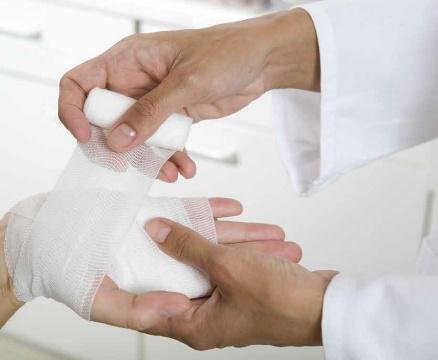Wound Care Program
Ultimate Plus Hospice’s Wound Care program expertly brings together our team of skilled in-home clinicians from different disciplines and uses the latest physician-supervised processes in order to detect, intervene, and resolve problems as quickly as possible. This program takes a comprehensive approach that helps individuals manage their diseases at home while avoiding unnecessary trips to the hospital.
Program Features
Supervised and supported by physicians
Personalized care plan
Processes informed by the latest research
Multi-discipline in-home clinical team
Education for family, caregivers, and patients
Wound Care Program Guide:
Comprehensive care guide including wound education, wound healing, treatments, nutrition, prevention and care, stress, oxygen therapy, nutrition, medication, and treatment goals tools
Symptom management tool to quickly and accurately identify changes in condition
Program Goals
Manage and improve symptoms
Reduce required visits to the hospital
Improve independence
Improve movement and activity
Educate on when to call for help
Wound Care – What you need to know
A wound is defined as an injury to the body that typically involves a cut, opening, or breaking of the skin and damage to underlying tissues. Each year, approximately 6 million Americans suffer from problem wounds caused by diabetes, circulatory problems, and other conditions – with 1.1 to 1.8 million new cases each year. The average time to closure of an acute wound (no complications) is 165 days. Proper care and the healing of the wound are important to your overall health.
Types of wounds:
Acute Wounds – A wound is “acute” when it has happened recently and is still within the normal time frame for healing.
Chronic Wounds – A wound is chronic when it has failed to heal as it should or when it keeps reopening.
Complex Wounds – The result of a major injury. Fat, muscle, tendon, or bone may be visible. These wounds generally have rough or torn edges and need immediate medical attention.
Surgical Wounds – Many surgeries require a cut through the skin which is later closed with tape, stitches or staples, or special glue. Surgical wounds often swell up and look bruised for a few days and they may drain small amounts of clear fluid.
There are four stages to wound healing:
Stage I – skin is intact and red in color
Stage II – looks like a shallow open ulcer or superficial erosion with a pink or red wound bed and has no slough
Stage III – full-thickness loss of the skin; necrosis of subcutaneous tissue. Subcutaneous fat may be visible, but tendon, muscle, and bone are not exposed.
Stage IV – Full-thickness loss of skin including the epidermis, dermis, and subcutaneous tissue. Muscle, bone, or tendon may be exposed.
Wound Healing
When an injury occurs to your skin, your body needs food, fluids, oxygen, and rest to best repair the wound. Also, knowing the specific cause can help determine how to best manage the wound and prevent further damage. When it comes to wounds, many people have misperceptions of how a wound best heals. Be sure to contact a medical professional to ensure your or your loved one’s wounds are being treated and healing properly.
For further information and to see if you qualify, please call 972-240-4700.




